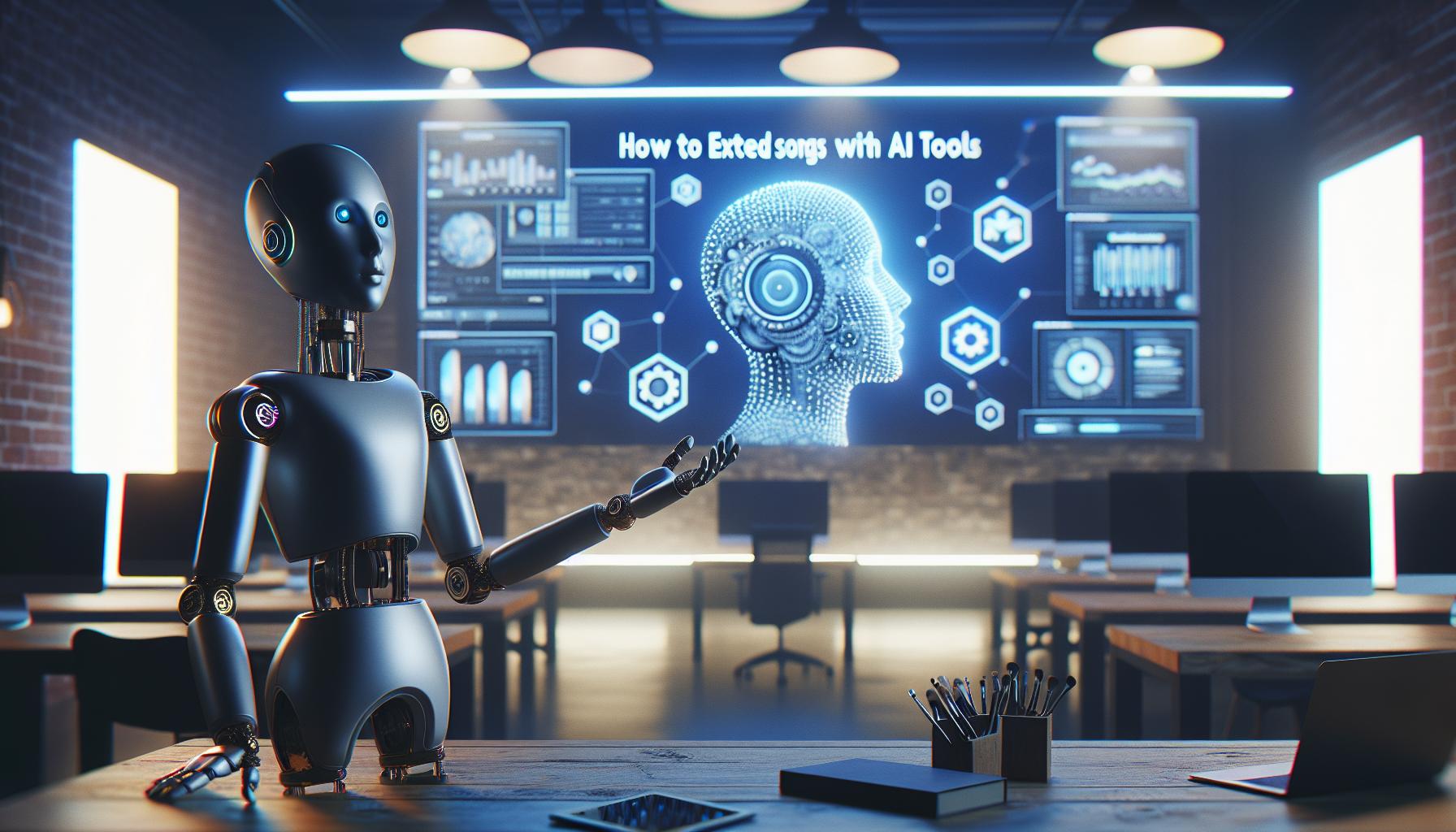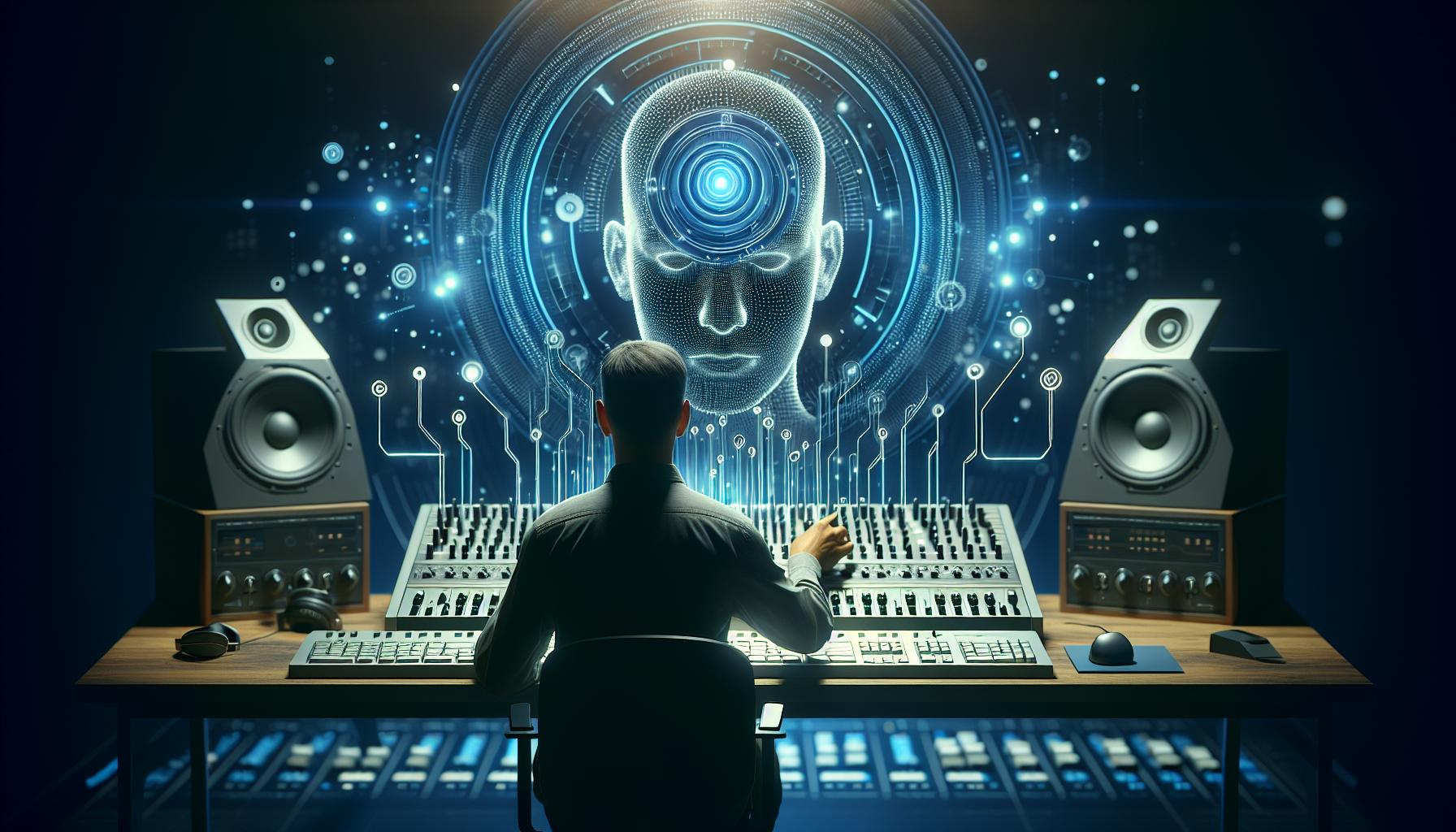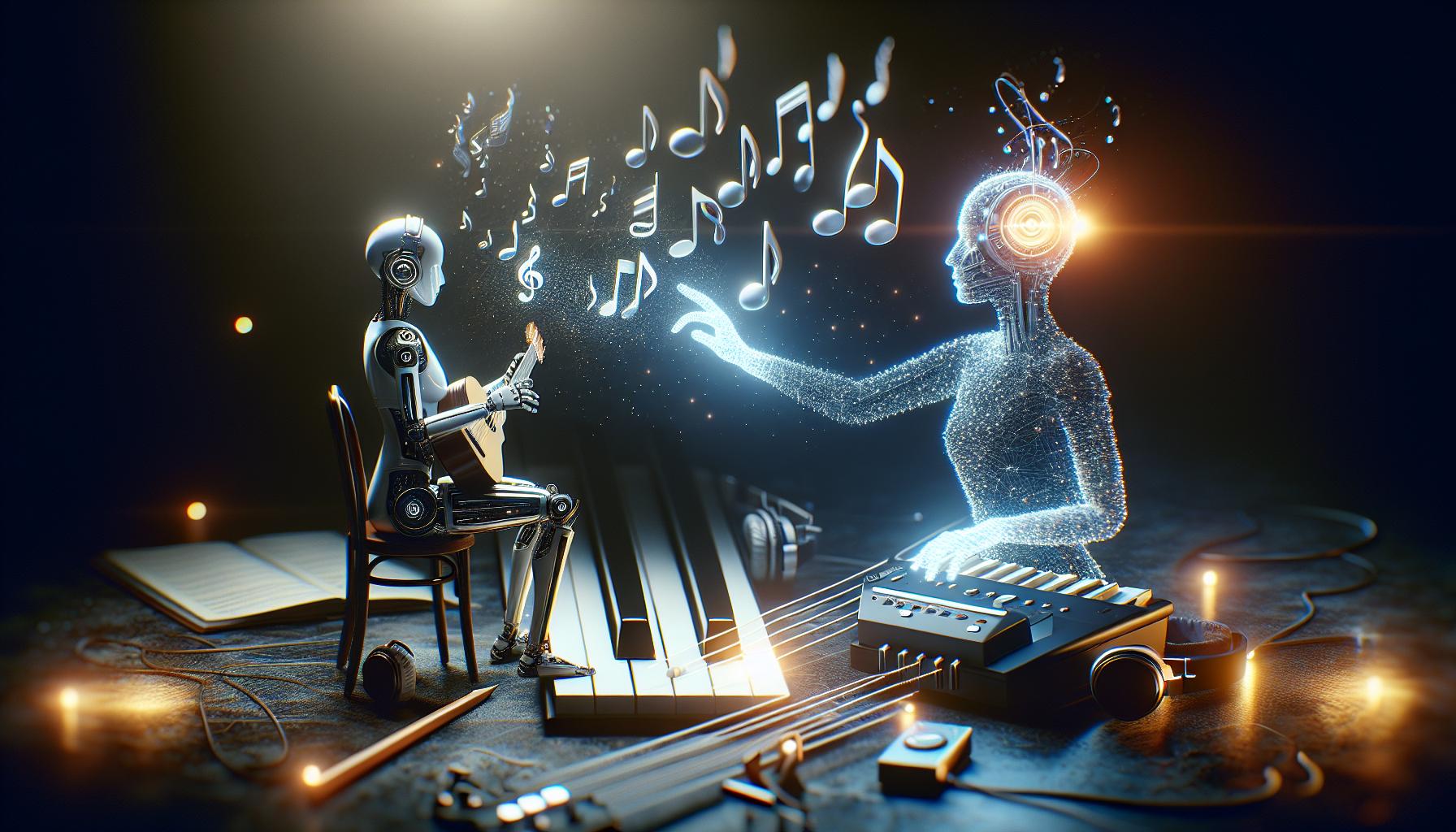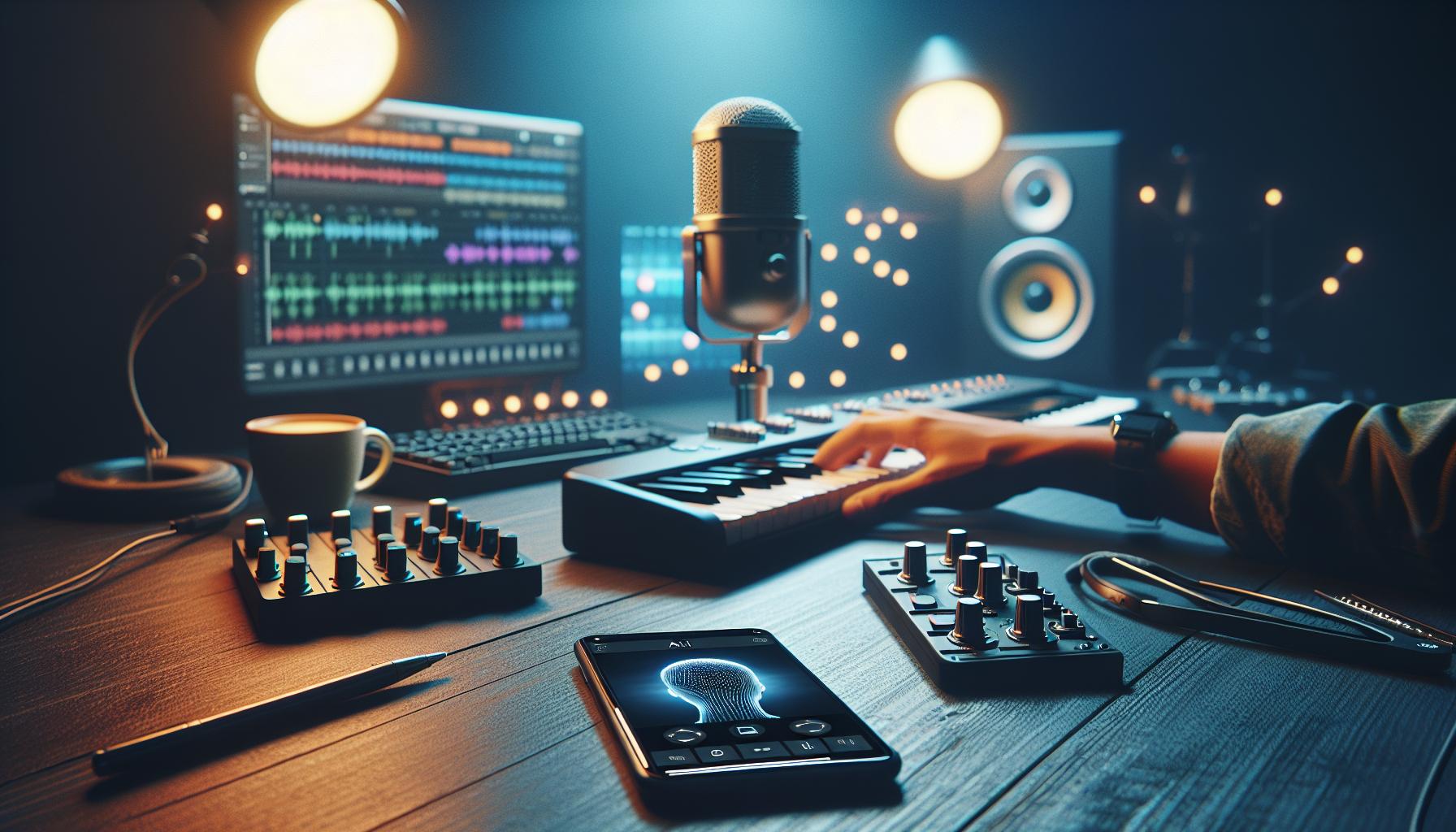In a world where attention spans are dwindling, musicians often grapple with creating songs that resonate yet feel complete. Leveraging AI tools can dramatically transform this creative process, offering innovative techniques to expand and enhance musical compositions. Discover how these digital advancements not only enrich your sound but also streamline your songwriting experience.
Understanding the Basics: What AI Can Do for Song Extensions
Did you know that artificial intelligence is revolutionizing the music industry by empowering artists and producers to extend songs creatively? With AI tools at their fingertips, they can manipulate and enrich their tracks in ways that were once reserved for expertly skilled musicians or complex software. By understanding the basics of what AI can do for song extensions,creators can harness these technological advancements to enhance their musical compositions dramatically.
How AI Transforms Song Extensions
AI algorithms play a crucial role in analyzing musical elements such as rhythm, melody, and harmony. They can generate new sections, help with transitions, and even create variations that align perfectly with existing melodies. Here are some capabilities of AI in song extension:
- Generating New Melodies: AI can craft additional melodies that fit seamlessly within the song’s style, providing a fresher sound without losing the original essence.
- Creating Unique Rhythms: Tools can analyze the existing BPM (beats per minute) and suggest new rhythmic patterns that enhance the track’s dynamics.
- Harmonizing Vocals: AI can support artists in adding harmonies or vocal layers, enriching the listening experience.
- Enhancing Instrumentation: Instruments can be digitally extended or added, allowing for experimentation with different sounds.
Practical Applications of AI in Song Creation
To illustrate how these AI capabilities can be applied, consider the following examples:
| Technique | Description | Example Tool |
|---|---|---|
| Melody Generator | Uses AI to create new melodic ideas that complement existing tracks. | OpenAI’s MuseNet |
| Rhythm composer | Allows producers to experiment with different rhythmic patterns and grooves. | Amper Music |
| vocal Harmonization | Suggests and layers harmonies over lead vocals. | iZotope Nectar |
| Sound Enhancement | Identifies and enhances specific frequencies of an instrument for clarity. | LANDR |
By exploring how to extend songs with AI tools, musicians can tap into a world of creative possibilities. These innovative techniques not only save time but also inspire new directions in their musical journey, equipping artists to produce tracks that captivate their audiences and set trends in the industry. Whether you’re a seasoned professional or an aspiring artist, understanding these basics can pave the way for creating unique, appealing music that stands out in a saturated market.
Creative Techniques: Leveraging AI for Lyric Expansion
Did you know that AI can generate entire verses of lyrics that align with your original writing style? This innovative potential is transforming the creative landscape for songwriters, enabling them to explore new dimensions of their work. By employing various AI tools, artists can expand their songs’ narratives, themes, and emotional richness, adding depth and complexity to their music.
Text Generation Tools
one of the most impactful ways to enhance your lyrics is through text generation. Platforms like OpenAI’s GPT models can definitely help expand single lines or transform them into full verses.Here’s how you can apply these tools effectively:
- Input Existing Lyrics: Start by entering a few lines from your song. use AI to maintain the same style, tone, and themes but ask it to continue or expand the ideas.
- Explore Variations: Generate multiple versions of a lyric to discover new phrases or concepts you might not have considered.This brainstorming process can spark fresh ideas.
- Combat Writer’s Block: Use AI tools to overcome creative stalls. When you feel stuck, letting AI suggest the next lines can help you find your rhythm again.
Emotional Tone Analysis
AI’s ability extends beyond generating text. Some tools analyze the emotions in your lyrics, providing insights that can help shape how you expand them. Tools like IBM Watson or Google cloud’s Natural Language API can evaluate the sentiment and emotional weight of your words.
| Emotional Tone | Suggested Themes for Expansion |
|---|---|
| Joyful | Celebration,Friendship,Nostalgia |
| Sad | Loss,Heartbreak,Reflection |
| Angry | Rebellion,Injustice,Liberation |
| Romantic | Idealism,Longing,Intimacy |
By understanding the emotional tone of your song,you can strategically expand or pivot your lyrics in ways that resonate more deeply with listeners. This process not only enhances the original message but also strengthens the connection audiences feel to your music.
Incorporating these AI techniques in your songwriting process allows you to explore uncharted creative territories. Whether it’s through generating new stanzas or understanding your emotional palette better, the integration of AI can serve as a powerful ally in extending your songs and making them more impactful. Don’t hesitate to experiment with these tools and see how they can bring fresh life to your lyrical compositions.
Enhancing Melodies: How AI Tools Transform Musical Composition
The Future of Music Creation
Music composition has always been a blend of artistry and intuition, yet the advent of artificial intelligence is fundamentally altering this landscape. Today, musicians and producers are leveraging sophisticated AI tools to not only streamline their creative processes but also to explore new musical frontiers.By harnessing the power of AI, artists can enhance their melodies and expand their sonic palettes, pushing the boundaries of traditional composition.
AI Algorithms as Creative Collaborators
Utilizing AI in music composition allows artists to collaborate with algorithms that can offer unique perspectives. Tools designed for melody generation can analyze existing musical pieces and create new variations or complementary phrases based on established patterns. For instance, AI software can dissect the tonal structure of a favorite song and propose new melodic lines that align harmonically, providing fresh inspiration for songwriters.
Here are a few specific ways AI tools can transform musical creation:
- Melody Generation: AI can suggest original melodies that resonate with the emotional tone of a song.
- Chord Progression Assistance: Advanced tools can analyze common chord progressions and generate alternatives that enhance musical depth.
- Finishing Touches: AI-driven software can assist in mixing and mastering, ensuring a polished final product that maintains the artist’s vision.
Real-World Applications
Notable examples of AI in action can be found in popular music charts. artists like Billie Eilish and her brother Finneas have incorporated AI-driven technology to enrich their soundscapes. Similarly,platforms like Amper Music and OpenAI’s MuseNet have democratized music creation,allowing anyone to craft melodies that echo the complexity of seasoned composers. These AI tools not only empower musicians but also inspire a new generation of creators to experiment fearlessly.
| AI Tool | Description | Key Features |
|---|---|---|
| Amper Music | An AI-driven tool for creating soundtracks | Customizable melodies,genre selection,instant export |
| OpenAI’s MuseNet | A multi-instrumental model capable of generating complex compositions | wide genre adaptation,style transfer,seamless integration |
| AIVA | An AI composer that learns from existing compositions | Personalized music creation,scoring for media,real-time editing |
With these innovations,artists not only learn how to extend songs with AI tools but also gain the freedom to roam vast creative landscapes,crafting nuanced and rich compositions that stand out in today’s musical marketplace.
Building Atmosphere: Using AI for Sound Design in Extended Tracks
Creating a captivating sound habitat is essential in engaging listeners and enhancing their emotional experience.With the rapid evolution of AI technology, sound design has undergone a conversion, allowing artists and producers to build immersive atmospheres in extended tracks. By harnessing AI tools, musicians can effortlessly expand their sonic palettes and explore novel creative pathways.
AI-Driven Sound Design Techniques
Utilizing AI in sound design unveils a myriad of techniques that can effectively enhance the atmosphere of extended compositions. Here are some strategies:
- AI-generated Soundscapes: Tools like Aiva or Endel can generate rich soundscapes that enhance the listening experience.Artists can input specific themes or emotions to receive tailored background audio that complements their extended tracks.
- Dynamic Sound Layering: AI software can analyze existing audio materials and suggest layers, harmonies, or effects that blend seamlessly. this technique allows for a richer texture without cluttering the primary elements of a track.
- Environmental Sounds Synthesis: Incorporating AI allows for the creation or manipulation of environmental sounds—like rain,wind,or urban noise—which can evoke a specific setting or emotion,making the extended track feel more immersive.
Practical applications in Extended Tracks
One practical example of using AI for sound design in extended tracks could involve the transition between different sections of a song. By employing AI algorithms, producers can create gradual fades or complex builds that transition smoothly between contrasting musical themes. This not only maintains listener interest but also creates anticipation.To illustrate the effectiveness of AI in creating atmospheric effects, consider the following table that summarizes notable AI tools and their specific sound design capabilities:
| AI Tool | sound design Feature | Ideal Use Case |
|---|---|---|
| Aiva | Automated composition | Score orchestration for atmospheric building |
| Endel | Soundscape generation | creating immersive backdrops for relaxation or introspection |
| Soundraw | Customizable loops | Layering unique elements in a track |
By integrating these AI-powered tools into the sound design process, musicians can transform their extended tracks into captivating, immersive experiences that resonate with listeners on multiple levels. This innovative approach not only supports the creative process but also pushes the boundaries of traditional music production.
Collaboration with AI: Navigating Human-Machine Partnerships in Music
Imagine a world where every musician can tap into an infinite reservoir of creativity, collaborating with sophisticated AI tools to push the boundaries of musical composition.This vision is becoming a reality as human-machine partnerships are reshaping the music landscape. By leveraging AI, artists are not only extending their songs but also enhancing their creative processes, enabling them to explore new genres and artistic expressions.
enhancing Creativity through AI
AI tools are transforming the traditional music creation process, providing musicians with innovative features that facilitate experimentation and inspiration. Whether it’s using generative algorithms to create melodies, employing machine learning to analyze song structures, or integrating AI-driven software to suggest harmonies and rhythms, the possibilities are endless. Here are some methods through which artists can effectively collaborate with AI:
- Melody Generation: AI models like OpenAI’s MuseNet can generate unique melodies based on a set of input parameters, helping musicians overcome writer’s block.
- Lyric Assistance: Tools that analyze existing lyrics can provide suggestions,enhancing the songwriting process with new perspectives and phrases.
- Sound Design: AI can suggest instrumentations and timbres that might not have been considered, broadening the sonic palette.
Real-World Applications of AI in Music
Many leading artists and producers are already utilizing AI tools to extend their songs and take musical innovation to new heights. For instance, a well-known pop artist recently collaborated with an AI engine to create an entirely new bridge for their single, resulting in a version that resonated even more strongly with their audience.This partnership not only saved precious studio time but also led to a unique sound that was a true blend of both human and machine creativity.
The following table showcases some popular AI tools available for musicians today, highlighting their key features:
| AI Tool | Primary function | Key Feature |
|---|---|---|
| AIVA | Composition | Generates original music based on preferred styles. |
| amper Music | Music Production | Create tracks utilizing customizable templates. |
| Endlesss | Collaborative Jamming | Real-time collaboration with remote musicians. |
though some may harbor concerns about the implications of AI in artistry, the reality is that these technologies can serve as powerful partners rather than replacements. By merging human intuition and emotion with the analytical prowess of machines, musicians can elevate their work, experiment with novel ideas, and ultimately extend songs with layers of depth and originality. Embracing AI doesn’t diminish the creative process; rather, it enriches and broadens the musical landscape for artists and listeners alike.
Ethical Considerations: The Implications of AI in Creative processes
The fusion of AI technology with creative endeavors has ignited a paradigm shift, especially within the music industry. As artists and producers increasingly turn to intelligent tools to enhance and extend their songs, the ethical landscape surrounding these advancements becomes more complex. The question arises: while AI can amplify creativity, what ethical considerations must we address to ensure a fair and responsible integration of these technologies?
Ownership and Attribution
One of the most pressing ethical issues is establishing ownership over AI-generated content. With tools that offer to extend songs or modify elements of existing tracks, the line distinguishing between human authorship and machine-generated contributions blurs. consider the following points regarding ownership:
- Artistic Attribution: who deserves credit for a song that has been digitally extended or modified by an AI tool? Should the creators of the AI, the musician using it, or the AI itself be recognized?
- Legal Frameworks: Current copyright laws may not adequately address the nuances created by AI in music production. Could we see new regulations that specify rights when using AI tools to create or modify music?
- Collaboration with AI: As AI becomes a co-creator rather than just a tool, it raises the question of how collaboration operates and how contributions are valued.
Impact on Artistic Integrity
Another ethical consideration centers around the potential impact of AI on the authenticity and integrity of musical expression. While AI tools can enhance creative processes, they might also lead to a homogenization of music. Artists risk losing the unique qualities that distinguish their work. Reflect on these aspects:
- Over-reliance on algorithms: As artists rely more heavily on algorithms to refine their sound or generate ideas, can they risk diluting their authentic voice or innovation?
- Market Saturation: With accessibility to AI tools, there is a chance of producing an overwhelming quantity of music that could make it challenging for unique voices to emerge and be heard.
- Diverse Expressions: Encouraging the use of AI for augmenting rather than replacing human creativity can help preserve the diverse expressions of different genres and cultures.
To navigate this evolving landscape, artists, producers, and stakeholders in the music industry must engage in meaningful conversations about ethics and best practices. Embracing AI tools as a supplement to, rather than a replacement for, human creativity may not only elevate individual artistic endeavors but also maintain the rich tapestry of sounds that characterize the music industry. By fostering collaborations that highlight both human and machine contributions, we can explore groundbreaking methods of extending songs responsibly while staying attuned to ethical ramifications.
Case Studies: Success Stories of AI-Enhanced Song extensions
Engaging with the possibilities of artificial intelligence can lead to truly remarkable transformations in the music industry. Musicians, producers, and tech enthusiasts are increasingly harnessing AI tools to extend songs creatively, frequently enough leading to elevated artistic expression and heightened audience engagement. Here are some compelling case studies that illustrate just how impactful AI-enhanced song extensions can be.
Reimagining Classics: the Case of ‘Bohemian Rhapsody’
One notable example is a digital project where an AI model was trained using the seminal hit “Bohemian Rhapsody.” By analyzing the song’s structure, harmonic progression, and stylistic elements, the AI generated new verses and choruses that retained the essence of the original while introducing fresh twists.
| Aspect | Original | AI-Extended |
|---|---|---|
| Verse Structure | 3 Verses | 4 Verses |
| Chorus Themes | Love and Regret | Adventure and Hope |
| Musical Complexity | Progressive Rock | incorporated Pop Elements |
The results were well-received on social media platforms, demonstrating that AI not only can replicate musical genius but also inspire new narratives that connect with diverse audiences.Artists were captivated by the hybrid creativity, which sparked collaborations with the AI-generated lyrics further enhancing the collective work.
A deep Dive into Personalized playlists
Another powerful request of AI song extensions came in the form of personalized playlists, like Spotify’s “Discover Weekly.” Using machine learning algorithms, Spotify analyzes listening habits and suggests songs that resonate with individual taste. As an example, a listener’s inclination towards indie pop can lead the AI to extend the experience through curated extensions that blend existing songs with new AI-created melodies.
- Increased Engagement: users spent 40% more time listening to extended playlists.
- Enhanced Emotional Connection: Songs blended with AI can evoke nostalgia by combining familiar elements from listeners’ favorite artists.
- Broader Artist exposure: Lesser-known artists can gain visibility through curated extensions that introduce their work alongside popular tracks.
With these techniques, the AI crafts not just a playlist but a journey through sound, illustrating just how powerful extensions can captivate audiences in our fast-paced digital age.
AI in Collaborative Music Projects
In collaborative projects, AI tools are pushing the boundaries of creative partnerships. For example, the platform OpenAI collaborated with musicians to develop arrangements that combine human creativity with AI-generated musical components. this synergy allows artists to co-create extended songs that showcase both human emotional depth and machine learning’s expansive data capabilities.
Such innovations offer various benefits:
- Streamlined Workflow: AI can suggest alternative chord progressions or melodies, reducing the time spent in the creative phase.
- Expansive Horizons: Musicians can experiment with genres that might be outside their expertise, thanks to AI-generated suggestions.
- Fresh Perspectives: The ability to generate entirely new musical phrases can lead to the advancement of unique soundscapes that surprise even the artists involved.
These case studies exemplify the new frontiers opened by AI in music production, confirming that understanding how to extend songs with AI tools can lead to prosperous and innovative outcomes in songwriting and creative development.
Choosing the Right AI Tools: A Guide for Musicians and Producers
with AI rapidly reshaping the music landscape, musicians and producers have a unique opportunity to enhance their creative processes.The right AI tools can help you not only extend your songs but also unlock a world of innovative sound design and production techniques. As you explore how to extend songs with AI tools, choosing the appropriate software is crucial for maximizing your creative potential.
Identifying Your Needs
Before diving into the myriad of AI tools available, consider what you want from the technology. Are you looking for assistance in songwriting, sound design, mixing, or perhaps generating new ideas for your next big hit? Breaking down your objectives will help you filter through the options effectively. Here are some crucial considerations to keep in mind:
- Purpose: Determine if your focus is on melody generation, arrangement, audio enhancement, or mastering.
- Skill Level: Choose tools that match your expertise—some are designed for beginners, while others cater to advanced users.
- Budget: Many powerful AI tools come with a price tag, so identify your budget and look for free or affordable alternatives if needed.
Evaluating Popular AI Tools
Once you have a clear understanding of your requirements, the next step is to evaluate some of the leading AI tools in the market. Below is a comparison of popular options tailored for extending songs using AI:
| Tool Name | Primary Use | Key Features | Price |
|---|---|---|---|
| AIVA | Composition | Generates orchestral compositions, customizable styles | Starting at $15/month |
| LANDR | Mastering | Automated mastering, AI-driven audio suggestions | Starting at $10/month |
| Amper Music | sound Design | Royalty-free music creation, genre selection | Free with in-app purchases |
| Sonible Smart:Comp |
Mixing | Intelligent compression settings, real-time analysis | $199 (one-time) |
trial and Integration
Most AI software offers trial versions or freemium models, allowing you to test features before committing to a purchase. This is an excellent way to explore how to extend songs with AI tools practically. Engage with the community around these tools for insights and tips on integration into your workflow. As an example, experimenting with AIVA’s composition capabilities can inspire new tracks while LANDR can ensure your mixes are polished seamlessly.
As you navigate through your options, don’t hesitate to combine tools to complement each aspect of your production process.Pairing Amper Music’s generative features with Sonible’s intelligent mixing can yield an notable sound palette that enhances your music far beyond traditional methods.
Future Trends: What’s Next for AI in Music Composition and Arrangement
Did you know that 70% of music industry professionals believe AI will significantly influence the evolution of music composition by 2025? as technological advancements unravel a plethora of creative opportunities, the future of AI in music is not only exciting but also ripe for exploration, especially in the context of extending songs using AI tools.
Emergence of Advanced AI Composition Tools
As AI continues to evolve, we can expect more sophisticated composition tools that learn from individual artists’ styles. These tools will offer tailored suggestions that align with the musical nuances distinctive to a creator’s body of work. imagine an AI-driven platform that analyzes hundreds of your past tracks and suggests chord progressions that you might not typically explore. This could not only save time when adding new sections to existing songs but also spark unique creative ideas.
- Intelligent Learning: Future AI tools may utilize machine learning algorithms that continuously adapt and refine their suggestions based on real-time feedback from artists.
- Emotion Recognition: We might see AI capable of analyzing the emotional impact of lyrics or melodies,allowing musicians to tailor their content to evoke specific feelings in listeners.
- Collaborative AI: musicians could engage in active collaborations with AI, where the technology contributes to the composition process as a co-creator rather than merely a tool.
Automation Meets Emotion
One of the most anticipated trends is the intersection of AI with melody and arrangement that emphasizes emotional intelligence. Tools that understand the context of a song—whether a bridge should draw on tension or a chorus should evoke joy—will be transformative.For example, an AI might analyze popular music trends and recommend variations in melody or structure to enhance a song’s emotional appeal.
| Feature | Potential Impact |
|---|---|
| Emotionally Intelligent AI | Creates music resonant with listener sentiments. |
| Advanced Analytics | Tracks listener engagement to inform creative direction. |
| AI-Powered Instruments | Dynamic sounds that adapt to atmospheric changes in a track. |
New Avenues for Collaboration and Distribution
The future also promises new forms of collaboration between AI and musicians. As AI-generated compositions gain credibility, artists will likely have more opportunities to experiment and remix works with AI-created elements, extending their songs into novel territories. Additionally, as tools become more accessible, a broader spectrum of musicians, from composers to hobbyists, will be able to leverage AI technology, democratizing music production in unprecedented ways.
The landscape of music composition is shifting. With advancements in AI tools for extending songs and collaborative opportunities on the horizon, artists have a chance to redefine creativity in music, blending their innate talent with the limitless possibilities of technology. Embracing these trends will not only enhance the artistic process but also pave the way for innovative musical expressions that resonate with future audiences.
Final Thoughts
the exploration of how to extend songs using AI tools unveils a myriad of creative techniques that merge technology with musical artistry. From employing machine learning algorithms to analyze existing tracks for stylistic elements, to harnessing generative models that can compose melodies and harmonies, the potential for innovation is boundless. As you delve deeper into these methodologies,consider the ethical implications of AI in music creation,such as copyright issues and the importance of human artistry in a digital age.
We encourage you to continue your journey by experimenting with the various AI tools discussed, and to reflect on how they can enhance your musical endeavors while respecting the intricacies of artistic integrity. Embrace the challenges and opportunities that AI presents, and don’t hesitate to share your findings and creations. Together, we can shape a future where technology and creativity coexist harmoniously.












